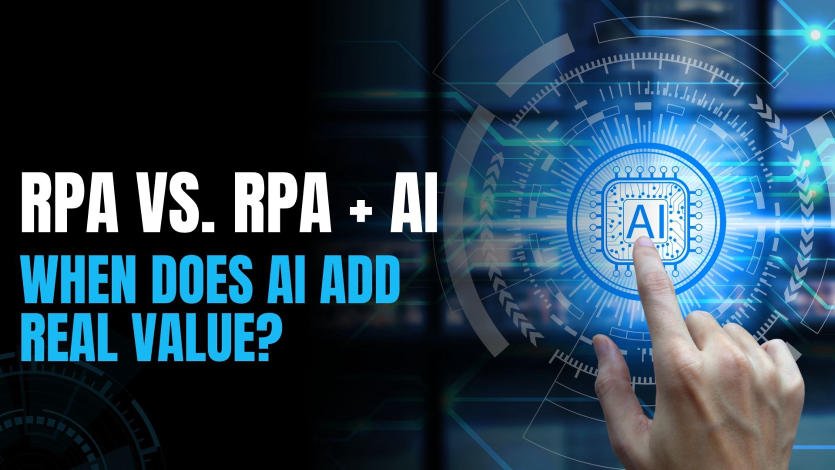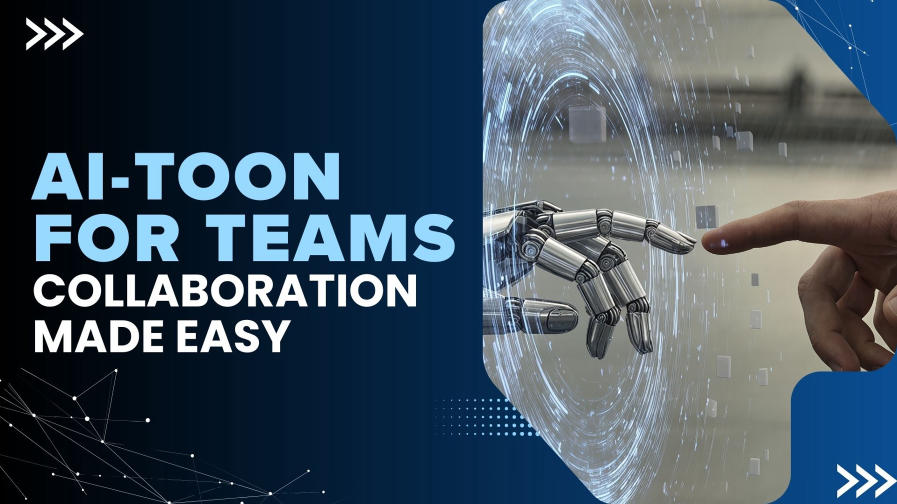Automation is redefining how organisations operate — from cutting down on repetitive tasks to granting access to intelligent decision-making. But there’s a major question for many companies: Do you stick with rule-based RPA, or combine RPA with AI and machine learning?
Classic RPA as we know it has been a dependable workhorse for years, but the increased complexity of digital operations now requires smarter, adaptive systems. In this article, we will examine when RPA + AI (or ML) is appropriate, how it differs from pure RPA and what makes successful companies that offer RPA implementation services so great.
Understanding the Basics: RPA vs RPA with AI and ML
Robotic Process Automation (RPA) is technology that offloads repetitive rule-based tasks – like data entry, invoice processing or report generation. It emulates human behaviour, such as clicking on buttons, copying data or creating reports — but without human judgment.
But, where processes are less predictable, pure RPA wobbles when faced with exceptions and unstructured content. That’s where machine learning consulting and AI automation company solutions play a role.
Sure, when you combine RPA with AI (or ML), bots don’t merely execute static rules; they learn and adapt and improve over time. It is called Intelligent Automation or AI-based RPA.
For Example: A bank that has already deployed RPA for processing loans can now include ML models in the workflows to evaluate dynamic credit risk analysis. Rather than discard applications with missing data, AI models generally fill in these gaps or intelligently flag exceptions.
When to Choose a Rule-Based RPA Solutions Provider Over an AI RPA Implementation
This explains why you should not spend on AI integration until you’ve acknowledged that pure RPA already accomplishes the job efficiently.
1. The Process Is Stable and Governed by Rules
If your process flows according to clear, predictable guidelines — such as invoice matching or employee onboarding, let’s say — RPA implementation services can be used to automate it, from start to finish and end-to-end (no AI required).
Take the case of back-office data entry or compliance checks in banking that rarely involve judgment.
2. Structured Data Is Available
If all your data is in “clean” sources (databases, spreadsheets, forms) you probably don’t need ML or AI.
With your scripts in place, RPA bots can extract, validate and upload data rapidly.
3. Low Variability and High Volume
RPA development service suits best for processes with the least variance – like payroll processing or data migration.
AI would only drive up costs without creating much value.
When RPA + AI (or ML) Makes Sense
Where automation really excels, however, is when we hit that unstructured data or decision-making or unpredictability on behalf of businesses. This is where RPA with AI solutions can drive speed and smarts.
1. Dealing with Unstructured Data
More than 80% of enterprise data is unstructured — such as emails, PDFs, scanned documents or voice files as per the report of IBM.
Rule-based RPA could not itself read or interpret this data.
When machine learning automation service is plugged in, bots can:
- Mine invoices or contracts for information using NLP.
- Understand customer queries from emails.
- Categorise documents based on context.
Example: A healthcare organisation employing RPA with ML can automate claims processing even when data formats vary or include hand-written text.
2. Complex Decision-Making
When automation needs judgment — for some applications such as fraud detection, loan admission or sentiment analysis — AI RPA implementation is inevitable.
ML can study historical data and take predictive decisions, whereas RPA will carry out the actions on its own in an automated fashion.
For example, AI-powered RPA bots doing document analysis at JPMorgan Chase save over 360,000 work hours annually.
3. Dynamic, Evolving Workflows
Processes change all the time in industries such as e-commerce or logistics. Conventional bots frequently fail when rules change.
By partnering with an RPA solutions provider that incorporates AI, you have bots that learn from new data inputs and can adjust automatically — resulting in less downtime.
Example: Amazon leverages Intelligent automation solutions to run its supply chain more effectively, examining order trends on the fly and making stock predictions accordingly.
4. Enhancing Customer Experience
By virtue of the AI-based Custom Chatbot service, businesses can deliver 24/7 smart support.
With RPA in place, chatbots are now doing more than just chatting: they also take actions — resetting passwords or updating records and workflows continuously.
According to Gartner reports – 65% of customer service will be conversational AI and automation by 2026.
Calculating ROI: When AI Automation Company Integration Pays Off
AI-driven automation is significantly more expensive at the start. So, before making the leap, companies should consider:
- Data quality — AI learns based on examples; garbage in, garbage out.
- Variability – The more variability, the higher the preference to integrate AI.
- Anticipated scale — If the process is performed thousands of times a day, AI’s predictive capabilities can generate compounding savings.
According to a 2024 report, McKinsey found that companies who are utilising AI-powered RPA saw increases in process efficiencies of up to 40% and along with cycle times up to 25% faster than those who rely on rule-based automation alone.
Key Advantages of RPA + AI Combination
Smarter Decision-Making
AI basically adds context and understanding to RPA. Bots can give orders based on patterns, not just by setting static rules but also dynamically.
Reduced Manual Intervention
Smart bots really reduce human intervention, resulting in a reduction of the cost of operations by up to 60% in some sectors.
End-to-End Automation
From data collection to analytics, integrating Custom RPA software with ML ensures seamless business process automation services.
Scalability and Adaptability
An RPA implementation company can generally build AI-RPA architectures that are modular and also adapt to changes in business perspective.
Best Tips for Implementing RPA + AI
If you’re planning to combine automation technologies, follow these best practices to maximize ROI:
- Start Small: Implement one to two high-impact practices at a time.
- Work with experts: Work with a qualified and along with some years of experienced RPA consulting services organisation and machine learning consultants to expect quality outcomes.
- Data Focus: Guarantee clean, labelled and non-biased datasets for precise ML training.
- Track Performance: Always try to continuously monitor key performance indicators such as accuracy, error rate and time saved during the work process.
- Scale Slow: After the proof of concept has been established, scale across functions easily outsourced to RPA service providers.
Industries Benefiting Most from RPA with AI Solutions
Here are some of the Benefits of implementing RPA with AI solutions:
| Industry | Use Case | Impact |
| Banking & Finance | Fraud detection, KYC automation | Reduced manual checks by 70% |
| Healthcare | Claims processing, patient data analysis | 2x faster claim resolutions |
| Retail | Demand forecasting, chatbot support | 35% higher customer retention |
| Manufacturing | Predictive maintenance, quality inspection | 25% cost reduction |
| Telecom | Billing, complaint resolution | 30% faster ticket closure |
How to Choose the Right RPA Solutions Provider or AI Automation Company
Choosing a wrong automation method can definitely ruin your workflows and processes of your business and therefore your success all depends on choosing the right RPA solutions provider or AI automation company. Look for:
- Those have a demonstrable experience with Intelligent automation solutions.
- Ability to Hire RPA developers who are capable of ML.
- Case studies showing measurable results.
- Agile deployment options with never-ending support.
Strategically applied, RPA and AI in concert can fuel end-to-end automation solutions that change business operations even though.
Quick Tip: Start Small and Scale Smart
Before implementing enterprise RPA at the cognitive level, select a few high-impact processes and run pilots. Monitor metrics such as reduced errors, cycle time and cost savings. Leverage this information to fine-tune models, streamline workflows and bring everyone together with speed and confidence.
Small starts bring measurable ROI with lower risk, which makes it easier for you to scale your RPA implementation services and machine learning automation services enterprise-wide.
Final Takeaway: Don’t Just Automate — Evolve
Pure RPA automates “doing.” AI-powered RPA automates “thinking.”
As processes are increasingly dynamic, rules must be adapted to adaptive intelligence for businesses to remain competitive.
Whether you’re a middle-level business or a major enterprise, the fusion of RPA implementation services with machine learning automation services, which was once a distant dream, is now available for deployment — it’s imperative to stay ahead in today’s competitive market.
Build small, blend in slowly, and enable your automation to become smarter with each interaction.




